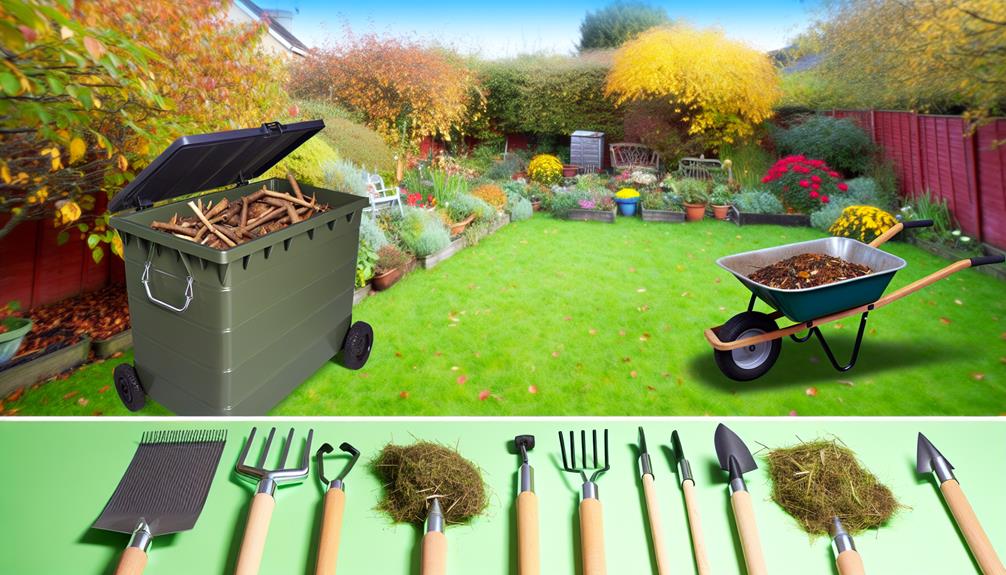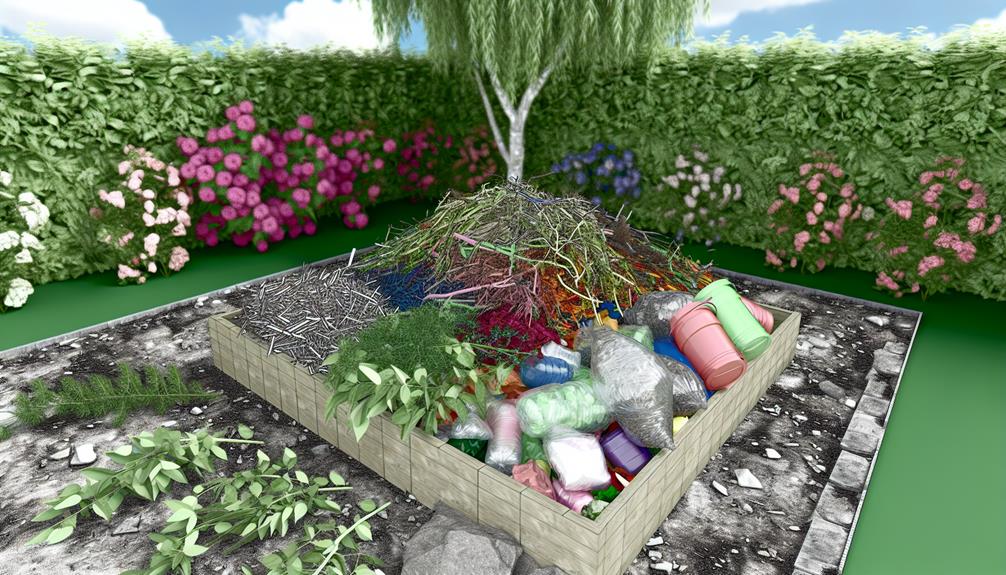

Yes, you can compost yard trimmings to create nutrient-rich soil, reduce waste, and support a healthy garden ecosystem. Start by gathering green materials like grass clippings and brown materials like fallen leaves. Aim for a balanced mix, with a 2:1 ratio of browns to greens.
Choose a sunny spot with good drainage, and layer your materials to guarantee proper aeration. Turn the pile every few weeks to speed up decomposition. Avoid meat, dairy, and oily foods to deter pests. Using the right tools and methods will make the process smoother. By managing your compost pile correctly, you’ll see the full benefits.
Composting yard trimmings offers numerous benefits, including reducing waste and enriching soil. You’ll find that composting not only helps the environment but also provides substantial health benefits for your garden. By composting, you return valuable nutrients to the soil, promoting healthy plant growth. This practice can lead to more robust vegetables and flowers, which in turn can improve the overall health of your garden ecosystem.
Another significant advantage is the sense of community involvement that comes with composting. Engaging in composting can bring neighbors together, fostering a shared commitment to sustainability. You can start a neighborhood composting project or participate in local composting workshops. These activities create a sense of belonging and collective effort towards taking care of the environment.
Additionally, composting can reduce your reliance on chemical fertilizers, which often contain harmful substances. By using compost, you’re ensuring that your garden receives natural, organic nourishment. This not only helps your plants thrive but also supports a healthier ecosystem.
Also Read: Can You Compost Barbecue Sauce?
When composting yard trimmings, you’ll encounter grass clippings, fallen leaves, and pruned branches.
Grass clippings add essential nitrogen to your compost, while fallen leaves provide necessary carbon.
Pruned branches, although needing more time to break down, can be managed effectively by chipping them into smaller pieces.
Grass clippings provide a fantastic source of nitrogen, which speeds up the composting process and enriches the soil. When you use grass clippings for lawn fertilization, they release nutrients as they decompose, feeding your grass naturally. This reduces the need for chemical fertilizers, making your lawn maintenance more sustainable and eco-friendly.
In addition to fertilization, grass clippings are excellent for mulch creation. By spreading them around your garden beds, you can retain moisture in the soil, suppress weeds, and regulate soil temperature. This not only promotes healthier plant growth but also saves water and reduces the need for frequent weeding.
To get the most out of your grass clippings, it’s best to mow regularly and avoid letting the grass grow too tall. When you do this, the clippings are smaller and break down more quickly. Also, make sure the grass is dry before you mow to prevent clumping and encourage even distribution.
Among the various types of yard trimmings, fallen leaves are incredibly versatile and beneficial for composting. When you gather fallen leaves, you’re collecting a valuable resource that can enhance your compost pile and garden.
They break down into a rich, dark material known as leaf mold, which improves soil structure and water retention.
To use fallen leaves effectively, consider them as excellent mulch alternatives. Simply spread a layer of shredded leaves around your garden beds. This natural mulch helps retain moisture, suppress weeds, and gradually enriches the soil as it decomposes.
Shredding the leaves speeds up the decomposition process and prevents them from matting, which can hinder water and air flow.
Start by raking the leaves into a pile and running them through a lawn mower or leaf shredder. You can then add them directly to your compost bin. Mix them with green materials like grass clippings or vegetable scraps to balance the carbon-to-nitrogen ratio. Turning the pile occasionally will help it decompose more uniformly.
Using fallen leaves in these ways not only reduces waste but also fosters a sense of connection to your garden. You’re transforming what might seem like yard waste into valuable resources, supporting a healthier, more sustainable environment.
Handling pruned branches effectively can make a significant difference in your composting efforts and overall garden health. First, you’ll want to contemplate wood chipping. By breaking down larger branches into smaller pieces, you not only expedite the decomposition process but also make them easier to manage.
Here’s how to handle pruned branches:
Wood chipping and branch mulching are essential techniques to make the most out of your pruned branches. Not only do they help in creating rich compost, but they also contribute to the health of your soil and plants. By integrating these methods, you strengthen your garden’s ecosystem and make sure that nothing goes to waste.
Also Read: Can You Compost Artichoke?
To kick off your composting journey, gather a mix of green and brown yard trimmings to guarantee a balanced compost pile. Green materials like grass clippings and vegetable scraps provide nitrogen, while brown materials such as dry leaves and twigs offer carbon. Mastering these composting basics will set you on the right path for starting compost effectively.

Start by choosing a suitable location for your compost bin or pile. It should be a spot with good drainage and partial sunlight. Next, create layers of green and brown materials. Aim for a 2:1 ratio of browns to greens to maintain the ideal balance. Water the pile just enough to keep it moist, but not too soggy.
Here’s a quick guide to help you categorize your yard trimmings:
| Green Materials | Brown Materials | Avoid These |
|---|---|---|
| Grass clippings | Dry leaves | Diseased plants |
| Vegetable scraps | Twigs | Treated wood |
| Fresh weeds | Cardboard | Pet waste |
| Coffee grounds | Paper (non-glossy) | Invasive species |
Turn your compost every few weeks to aerate it and speed up decomposition. By following these steps, you’ll create rich, fertile compost that benefits your garden and reduces waste. Welcome to the composting community!
Also Read: Can You Compost Baking Soda?
Once you’ve gathered your materials and set up your compost pile, it’s time to explore different composting methods to find the best fit for your needs. There are various ways to compost yard trimmings, each with its own benefits and requirements.
Choosing the right method depends on your available space, the amount of yard trimmings you have, and your personal preferences. Try one or combine methods to see what works best for you. Each technique has its own unique advantages, helping you turn yard waste into valuable compost for your garden.
For effective composting, you’ll need a few essential tools to manage and maintain your compost pile. First and foremost, invest in compost bins. These bins help contain your yard trimmings and other compostable materials, making it easier to manage the pile and keep your composting process tidy. Compost bins come in various sizes and styles, so choose one that fits your space and needs.
Next, you’ll need a sturdy garden fork. This tool is invaluable for turning and aerating your compost pile, making sure that oxygen is evenly distributed. Proper aeration speeds up the decomposition process and prevents unpleasant odors. A garden fork with a long handle and durable tines will make this task much easier.
Another helpful tool is a compost thermometer. Keeping an eye on the temperature ensures that your compost is decomposing correctly. If the temperature drops too low, you might need to adjust your pile.
Lastly, consider having a pair of gardening gloves. They’ll protect your hands from any sharp objects or irritants within your pile.
Also Read: Can You Compost Aubergine?
Effectively managing your compost pile guarantees that your yard trimmings break down efficiently and turn into nutrient-rich compost. Start by ensuring a good balance between green and brown materials. Green materials include grass clippings and vegetable scraps, while brown materials consist of dry leaves and twigs. This balance helps the decomposition process.
To keep your compost pile healthy and productive, focus on the following:
Also Read: Can You Compost Bag?
When composting yard trimmings, you might encounter a few common mistakes that can hinder the process.

Watch out for contaminated yard debris, as it can introduce harmful substances into your compost.
Also, make sure you maintain the correct compost ratios and proper moisture levels to keep your pile healthy and efficient.
Though it might seem harmless, adding contaminated yard debris to your compost can introduce harmful chemicals and pests. It’s essential to be vigilant about what goes into your compost pile to maintain its integrity and safety. Here are some common contaminants to watch out for:
To avoid these issues, always check the origin of your yard debris. Opt for organic and untreated materials whenever possible. If you’re unsure about the history of certain trimmings, it’s best to leave them out.
A common mistake in composting isn’t maintaining the correct balance between green and brown materials. Green materials, like grass clippings and vegetable scraps, are rich in nitrogen, while brown materials, such as leaves and branches, provide carbon. To create an effective compost pile, you need to aim for the proper carbon ratio, usually around 30 parts carbon to 1 part nitrogen.
When the nitrogen levels are too high, your compost pile can become slimy and emit unpleasant odors. On the other hand, if you have too much carbon, the decomposition process will slow down, making it take longer for your compost to become usable. To avoid these issues, layer your materials thoughtfully. Start with a base of coarse brown materials, then add green materials, and continue alternating layers.
Mixing the pile regularly ensures that the materials break down evenly and helps maintain the ideal carbon ratio. If you’re new to composting, consider using a compost calculator or guide to help you get the right balance.
Maintaining your compost pile at the correct moisture level is essential for efficient decomposition. Too much or too little moisture can disrupt the balance, leading to common composting problems. Moisture imbalance is a frequent issue that can slow down or even halt the composting process.
To guarantee your compost pile thrives, remember these key points:
Maintaining the right moisture balance helps create an environment where microbes can thrive, breaking down yard trimmings efficiently. Neglecting this can lead to a pile that’s either too dry to decompose properly or too wet, causing it to smell and attract pests.
When composting yard trimmings, you might encounter issues like foul odors, slow decomposition, or pest infestations. Don’t worry—these are common problems with simple solutions.
For foul odors, check your pile aeration. A well-maintained pile guarantees that oxygen reaches all layers, reducing the chance of anaerobic bacteria taking over and causing bad smells. Turn your pile regularly, at least once a week, to improve airflow.
If your compost is decomposing slowly, it’s likely due to low compost temperature. The ideal range is between 135°F and 160°F. If the temperature is too low, your pile may need more nitrogen-rich materials like grass clippings or kitchen scraps. Mixing these in will help heat things up.
Pest infestations are another issue you might face. To prevent pests, make sure to bury food scraps deep within the pile, at least 10 inches below the surface. Avoid adding meat or dairy, as these attract unwanted visitors. If pests persist, consider using a compost bin with a lid to keep them out.
So, how do you make the most of your finished compost?

Once your yard trimmings have transformed into rich, dark compost, it’s time to put it to good use. Incorporating compost into your gardening routine can greatly enhance soil health and plant growth. Here’s how you can maximize its benefits:
Also Read: Can You Compost Asparagus?
When you compost yard trimmings, you greatly reduce landfill waste.
This process also enriches soil health by returning essential nutrients to the earth.
Additionally, composting helps lower your carbon footprint by reducing methane emissions from landfills.
Did you know that composting yard trimmings can greatly reduce the amount of waste that ends up in landfills? By turning your grass clippings, leaves, and branches into compost, you’re actively participating in a more sustainable waste management system.
This simple practice not only conserves valuable landfill space, but also mitigates the environmental impact of waste disposal. When you compost, you contribute to a communal effort that benefits everyone.
Here are some key reasons to start composting your yard trimmings:
By composting yard trimmings, you enrich your soil with essential nutrients and organic matter, creating a healthier environment for plants. Composting promotes microbial activity, which breaks down organic materials into a rich, dark soil amendment known as humus. This humus is packed with nutrients that your plants will love, including nitrogen, phosphorus, and potassium.
Vital microbial activity is essential for nutrient cycling, the process where nutrients are converted into forms that plants can easily absorb. When you add compost to your soil, you’re not just feeding your plants; you’re also supporting a thriving ecosystem of beneficial microbes. These microbes improve soil structure, increase its water-holding capacity, and enhance root growth.
To get started, gather your yard trimmings such as grass clippings, leaves, and small branches. Chop larger pieces to speed up decomposition. Layer these trimmings with kitchen scraps and other compostable materials in a compost bin.
Turn your compost pile regularly to aerate it, which boosts microbial activity.
Composting yard trimmings greatly reduces your carbon footprint by diverting organic waste from landfills where it would otherwise produce harmful methane emissions. By incorporating composting into your routine, you’re not only helping the environment but also embracing sustainable practices that benefit your garden and community.
When you compost yard trimmings, you’re actively contributing to organic gardening by enhancing soil fertility and structure. Here are a few ways composting helps lower your carbon footprint:
Adopting composting as part of your gardening routine is a straightforward and impactful step towards sustainable practices. It aligns with the principles of organic gardening and supports a cleaner, greener planet.
Yes, yard trimmings can attract pests if you don’t compost them properly. For effective pest prevention, make sure proper compost aeration. This helps maintain a balanced environment, making you feel part of an eco-friendly community.
You’re wondering about the composting process for yard trimmings? Typically, the decomposition timeline takes about three months to two years. It depends on factors like moisture, temperature, and how finely you’ve chopped the materials.
You should never compost invasive species or diseased plants. They can spread and harm your garden, disrupting the community you’re building with your compost. Stick to healthy trimmings for a safe, vibrant compost pile.
Certainly, composting yard trimmings can greatly reduce yard waste disposal costs. By turning waste into nutrient-rich compost, you achieve waste reduction and enjoy cost savings, while contributing to a more sustainable, eco-friendly community.
You shouldn’t compost yard trimmings treated with pesticides. Pesticide residues can lead to soil contamination, harming plants and beneficial organisms. Join others in creating a safe compost by avoiding chemically treated materials and protecting your garden.
By composting your yard trimmings, you’ll enrich your soil, reduce waste, and support a healthier environment. Begin with a mix of green and brown materials, and choose the composting method that fits your space and needs.
Use the right tools, avoid common mistakes, and troubleshoot any issues promptly. When your compost is ready, apply it to your garden to boost plant growth.
Embrace composting, and you’ll see a significant positive impact on your garden and the planet.

Don't let aphids, slugs, and caterpillars ruin another plant. Take back control with simple, natural methods that actually work.